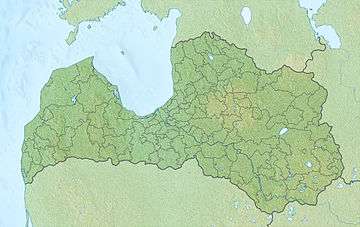Zvejnieki burial ground
 Shown within Latvia | |
| Location | Lake Burtnieks |
|---|---|
| Coordinates | 57°46′34″N 25°13′34″E / 57.776°N 25.226°E |
| Type | Burial ground |
| History | |
| Founded | 7500 BC[1] |
| Abandoned | 2600 BC[1] |
| Periods | Mesolithic / Neolithic |
| Cultures | Kunda culture, Narva culture, Comb Ware culture, Corded Ware culture |
The Zvejnieki burial ground is a Stone Age cemetery located along a drumlin on the northern shore of Lake Burtnieks in northern Latvia.
The site had been known among archaeologists since the nineteenth century. However, it was excavations led by Francis Zagorskis between 1964 and 1978 which uncovered the site.[2] Before the discovery of a human skull in 1964, the site was used primarily for quarrying gravel. Researchers estimate that the site originally contained over 400 burials.[1]
The cemetery contains 330 burials,[1] with roughly equal numbers of male and females.[3] About one third of the burials are children.[3] The principal grave goods are animal tooth pendants, occurring in both adult and child graves.[3] A smaller number of male and female graves contain hunting and fishing equipment, including harpoons, spears, arrowheads and fish-hooks.[3] The earliest burials are dated to the Middle Mesolithic, 8th millennium BCE, but they continue throughout the Stone Age, extending over at least four millennia.[3]
Two settlement sites have been identified close to the cemetery: Zvejnieki I (Neolithic) and Zvejnieki II (Mesolithic).[3]
Archaeogenetics
In 2017, researchers successfully extracted the DNA from the petrous bone of six adult individuals buried at Zvejnieki. DNA testing showed that Burial 121, which was previously thought to be female, was actually male, and that Burials 221 and 137, which were previously thought to male, were actually female.
DNA analysis shows that the people from Zvejnieki appears to have maintained genetic continuity from the Mesolithic to the Neolithic and likely adopted Neolithic practices through cultural diffusion, as the populations showed little genetic affinity for the Anatolian farmers that migrated to large parts of Europe during the Neolithic. However, a late Neolithic individual from Zvejnieki, Burial 137, appears to show some genetic affinity for the Caucasus hunter-gathers typified by an ancient DNA sample from Satsurblia Cave. [4]
| Burial # | Period | Culture | Dating | Gender | mtDNA | Y-DNA | Source |
|---|---|---|---|---|---|---|---|
| 313 | Mesolithic | Kunda culture | 8,417-8,199 BP | ♀ | U5a1c | NA | Jones etal, 2017[4] |
| 93 | Mesolithic | Narva culture | 7,791-7,586 BP | ♂ | U2e1 | R1b1b | Jones etal, 2017[4] |
| 121 | Mesolithic | 7,252-6,802 BP | ♂ | U5a2d | R1b1b | Jones etal, 2017[4] | |
| 124 | Neolithic | 6,201-5,926 BP | ♂ | U4a1 | Jones etal, 2017[4] | ||
| 221 | Neolithic | Comb Ware culture | 6,179-5,750 BP | ♀ | U4 | NA | Jones etal, 2017[4] |
| 137 | Neolithic | Corded Ware culture | 5,039-4,626 BP | ♀ | U5a1 | NA | Jones etal, 2017[4] |
References
- 1 2 3 4 Stutz, Liv Nilsson; Larsson, Lars; Zagorska, Ilga (2015). "The persistent presence of the dead: recent excavations at the hunter-gatherer cemetery at Zvejnieki (Latvia)". Antiquity. 87 (338): 1016–1029. doi:10.1017/S0003598X00049838. ISSN 0003-598X.
- ↑ Schulting, Rick J.; Fibiger, Linda (2012). Sticks, Stones, and Broken Bones: Neolithic Violence in a European Perspective. OUP Oxford. p. 38. ISBN 0199573069.
- 1 2 3 4 5 6 Eriksson, Gunilla; Lõugas, Lembi; Zagorska, Ilga (2003). "Stone Age hunter–fisher–gatherers at Zvejnieki, northern Latvia". Before Farming: The Archaeology and Anthropology of Hunter-Gatherers.
- 1 2 3 4 5 6 7 Jones, Eppie R.; Zarina, Gunita; Moiseyev, Vyacheslav; Lightfoot, Emma; Nigst, Philip R.; Manica, Andrea; Pinhasi, Ron; Bradley, Daniel G. (2017). "The Neolithic Transition in the Baltic Was Not Driven by Admixture with Early European Farmers". Current Biology. 27 (4): 576–582. doi:10.1016/j.cub.2016.12.060. ISSN 0960-9822.